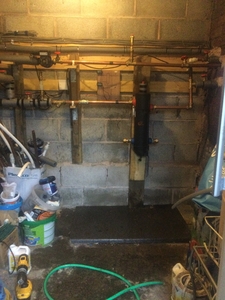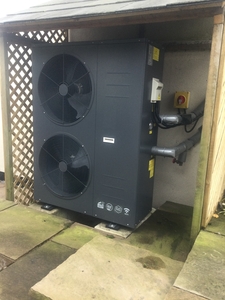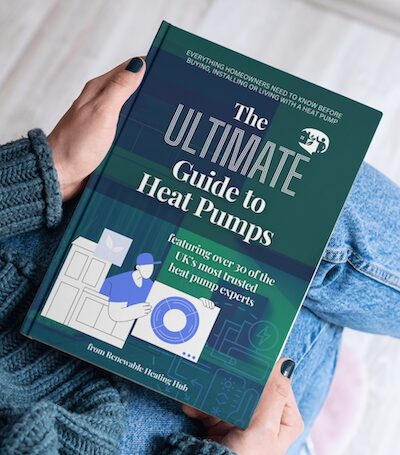My DIY Heat Pump installation
Hi All
New to the forum. I did post earlier in the year saying I was going to post the details of my DIY Heat pump installation but its been a busy year and not had time to do it. All finished now and so here goes.
The background
5 bedded detached house, the oldest part built in the early 1800's with various extensions over the years, was initially 2 cottages converted in to one house in the 70's. The last extension was by us of a big kitchen diner in 2010.
Locality is South Lancashire, walls are mainly solid in older part through to insulated cavity in the new extension. I have insulated as much as I can and double glazing fitted about 10 years ago.
Complicated heating as mostly done in the 70's, essentially the left hand side of the house (LHS) (was one of the cottages) is radiators all fed from a manifold terminating in 10mm microbore to the rads, right hand side (RHS) is similar to rads. New extension is UFH downstairs and radiators off a manifold fed by 15mm pipe. I replaced all the old radiators with type 22 about 5 years ago.
House was heated by oil when we moved in but at the time of the extension in 2010 I decided that oil was bad and going to get expensive so decided down the route of ASHP then. Very little info about then so decided along with my plumber/electrician to DIY then. Got 2 ASHP one 8.3KW and the other 11.3KW off the internet for about £ 1,500 each. The initial set up was the 8.3 unit was to do the hot water (DHW) and the 11.3 the heating. After a short while it was obvious that the 11.3 was struggling so on contacting the seller he suggested linking the two via a LLH and having zone valves controlled by thermostats and separate pumps to LHS, RHS, UFH and DHW. So this is what we did and it worked.....sort of. Over the years the house was kept warmish and the DHW was OK and topped up by immersion as necessary. It started getting expensive however and with the price of electric going up, very expensive. I also realised that the ASHP were nearly 15 years old now and not as efficient as they had been so all in all needed upgrading.
Looking at various links I was loathe to start spending tens of thousands of pounds on a new system and didn't want to go down the route of MCS with all the hassle. It is an old house and I didn't want people who I realised may be didn't know what they were doing coming and giving me bad advice.
So, I decided to do it myself, everything was there, it maybe just needed tweaking. I was lucky as I know an ASHP engineer who gave me some advice and my wife's cousin is a plumber who is now specialising in refits of botched ASHP installations, he also gave me advice.
Jan 2025
I was researching ASHP on the internet and getting quite shocked as to how much they cost, my old system came to a total of 19.6KW and I did a rough heat loss calculation off the internet and reckoned a 16KW system would do me. Other friends who had similar size houses and had spent £15K on installs had similar size models so it looked OK. As you can see all of this is generally 'back of an envelope' type stuff.
Then I found on ebay a brand new 16KW ASHP for £ 850! Far too good to be true and so the old adage of if it's too good to be true......
But I researched the company and got in contact, turned out they were a heating company in Wigan who's former CEO had bought 20x 16KW ASHP and 20x 9KW ASHP from China with a view to fitting them in to peoples homes. Trouble was he then realised he would have to send his engineers to China to get trained in how to fit them properly and this wouldn't be cost effective, so he was stuck with 40 ASHP. This is maybe when he became the former CEO. So I googled the ASHP, got in contact with my contacts and looked in to it. Downside was bought as seen, no warranty and no real advice as to how to fit them. But I thought for £ 850 I could take the gamble so I trundled over there with my trailer and a very nice lady driver in a fork lift truck plonked a brand new, unopened 16KW ASHP in and I bought it.
Foshan AIROSD 16KW DC abd EVI inverter ASHP, Monobloc unit with R32 refrigerant.
When the heating season was over I disconnected all the old plumbing and placed the unit in a new position outside, my electrician came and connected it but this was very straightforward as all the old wiring and controls were there from the previous ASHP.
After reading lots of blogs and forums such as this one I decided on the following set up.
No LLH, all run as an open loop system, the LLH is still there in the return pipe but plumbed as a 2 way LLH and is essentially a dirt and air seperator in the return pipe.
All zone valves taken out for LHS, RHS and UFH. All room thermostats disconnected
I still have the seperate pumps for LHS, RHS and UFH, so now a Salus pump set on highest constant pressure curve feeds 28mm pipe to three sperate zones, LHS with additional pump set at velocity 1, RHS with pump set at velocity 1 and UFH with pump set at velocity 1. I was unsure if this would work as had read about pumps in series but I reckoned that with the 10mm microbore pipe and the UFH being 60square metres in total a single pump wouldn't manage. All these pumps are linked to the main Salus pump which is controlled via the ASHP so all come on and off together. And it all seems to be working OK.
The DHW is now seperate as I decided that it would be more efficient for the ASHP to purely do the heating, also I couldn't figure out how to set up the controls for DHW. So DHW is now heated by an immersion heater but I have had an Iboost fitted this year as I have 10 solar panels as well and so for the whole of summer that heated all the hot water we needed and now as I am on Octopus EV tariff I pay 7p a KW to heat the water at night. I have it on for 1 hour so a maximum of 21p for loads of hot water at 60 degrees so far hotter than the ASHP would heat to.
And that is essentially it, the instructions for the unit are useless and all I can do is switch it on via a timer or have it on all the time. But that is not a problem as I now plan to run it just for 12 hours at night in this shoulder season when it is quite mild through the day and when it starts getting much colder will have it on all the time. It is set to 30 degrees return temperature so that the flow temperature is about 34 and it seems to quite happily modulate up and down as necessary. It does not seem to cycle much, if at all. I will have to keep an eye on things when it gets much colder and see if I need to increase the return and therefore flow temperature at all. It uses about 1
KWH of electric but for a big 5 bedded house I think that is reasonable and the house is 20 degrees at present so the wife is happy.
I will try to post a couple of pictures but may have to get the wife to help me do that.
Total cost has been about £1,000.
Thanks for posting, @polar-bear.
Do you have any stats or running costs for your new setup? You're obviously happy with the result but it's also be interesting to see how the advice you got from your botch-fixing cousin has helped get the install working as you need it.
One perhaps silly question, though; given the heat pump was £850, did you consider getting two and keeping one for spares given it's not a common unit in this country?
105 m2 bungalow in South East England
Mitsubishi Ecodan 8.5 kW air source heat pump
18 x 360W solar panels
1 x 6 kW GroWatt battery and SPH5000 inverter
1 x Myenergi Zappi
1 x VW ID3
Raised beds for home-grown veg and chickens for eggs
"Semper in excretia; sumus solum profundum variat"
It's really interesting to see just how far people are willing to go by themselves, and I can certainly see why, considering the cost of the install.
One thing that did occur to me while reading, however, was that Chinese systems like yours tend to hang their badge power on some fairly forgiving assumptions. From what I can see the 16kW rating is based on an OAT of 7C and a flow of 55. At -4C you might be looking at a maximum capacity closer to 14kW. Hopefully you don't find yourselves cold when really cold weather rolls in!
Hi
No real stats to speak of, in fact none.
I just keep an eye on my smart meter to see how may KW the whole house is using. I use a lot of electricity, we have an EV, DHW is immersion heater now. I have 5 pond pumps and 2 air pumps running all the time as well as 3 fridge/freezers and so my background usage is a bout 500 watt per hour. Anything above that I assume is the ASHP. All a bit Heath Robison I know but I am not too bothered and cannot work out COP etc. Is it working....yes. Is the house warm....yes. Are my electric bills cheaper....yes. So I am happy with that.
Good point about maybe should have bought 2, the 9KW on was only £ 650. I did ask friends if they wanted on but no one would commit. Downside is spares, things going wrong but as you probably know these things are pretty robust. My old ones were 15 years old and I never needed to do anything to them so I have my fingers crossed here that nothing will go wrong, I will have to cross that bridge as and when.
Good point and I will have to see how it performs when it is really cold. I had that problem with my old ASHP set up but this one does seem far more efficient at the moment. I have 2 wood burning stoves in the house so if/when it gets really cold I fire them up. We will have to wait and see. My concern is when it gets really cold will the electric consumption go up, well yes it will but I will have to heat the house somehow and I was getting through 4000 litres a year of oil in 2010 so that amount at todays prices will have to be taken in to account.
Really interesting post, and great work. I might have missed it but are you able to set up a weather compensation curve or do you just have to run a set outlet/inlet flow temp with it?
As I said the instructions are rubbish. I have contacted someone from the company in China but not got much useful info from them. I think it has its own compensation curve but not sure what it set at. I can only vary the return temp and have set this to 30, it reaches this after about 15 minutes and then seems to modulate with the fan slowing down and using less electric and flow temp seems to be about 34 so a delta T of about 4. This has worked very well up till now but the lowest outside temp has been about 5 overnight. So I will have to see how it fares when the temp is freezing all day and what I will have to set the return temp and what the corresponding flow temp will be and then how much electricity that will use. Not ideal but what do you want for 850 quid.
@polar-bear, I take my hat off to you. I wish I had the skillset to take something like this on. The unit itself looks smart enough. Yeah, bummer about the Chinese instructions. Is there an electronic/digital manual because Deepseek or ChatGPT could translate that? Then you’d kinda know where the settings are? Is the controller Chinese too or is there an English option?
Get a copy of The Ultimate Guide to Heat Pumps
Subscribe and follow our YouTube channel!
That is kind, this site and your blogs were my main source of info.
I Don't want to blow my own trumpet but it was all quite basic plumbing skills. The electrics were done separately but as I said were very straightforward as basically a like for like replacement. So although the plumbing was fairly basic what I really wanted to do this time was get the set up right so spent a lot of time through the summer researching and that is why I went down the route of.....
No buffer or LLH as I didn't want any mixing, all the hot water the ASHP produces goes directly in to the house.
Open loop system so as much water volume as possible so that the ASHP can do its thing.
All zone valves and thermostats taken out of the equation so it just becomes a simple on/off system and my plan is to run it as low as I can for long as I can.
All pumps connected together controlled by the ASHP so they all come on and off at the same time.
DHW now separate from the ASHP so that will just have to deal with heating the house.
You are correct that the unit looks very good and solid and seems to work very well, I am pleased with that. The control box is quite basic, on/off, timer, return water temp but as I say the way I plan to run it is going to be very simple anyway so that may be no bad thing. The instruction booklet is in quite good English, you actually down load it from the site, its just that there is no really useful information on it.
All of this may be no bad thing as I am afraid my temperament is that of a fiddler in as much that if I were able to meddle and push buttons and change things I would probably be doing so most days. With this system I will just have to leave it alone to do it's thing as there is not much more I can do.
@pollar-bear Top job, I installed my own too and even though it is basic plumbing skills, There was always the nagging doubt "what if I f*** this up and lose a lot of money". Would be interesting to get some monitoring and see what any tweaks you might make do. 🙂
House-2 bed partial stone bungalow, 5kW Samsung Gen 6 ASHP (Self install)
6.9 kWp of PV
5kWh DC coupled battery
Blog: https://thegreeningofrosecottage.weebly.com/
Heatpump Stats: http://heatpumpmonitor.org/system/view?id=60
Yes, always a bit of a risk as to whether it will all work, but did a lot of research and was quietly confident. Can't upload data but will try to give a monthly indication of electric used (will be a ball park figure) and what temp the house is being held at, this ultimately is all I am interested in rather than getting bogged down with specific COP's. I have turned it off at the moment because in this very mild weather the house is too warm, never thought I would be longing for the cold weather to start!!
Attached is a very simplified diagram of my very simple set up.
All the major pipe work shown is 28mm, going down to 15mm for the UFH and 22mm down to 10mm for the rads.
One point people may or not be interested in is that there is no anti freeze in the system so just pure water as the heat exchanger. Also I have not fitted anti freeze valves outside. My theory here is that I am unlikely to get a prolonged power cut lasting greater than 24 hours when it is below freezing which would freeze the ASHP. More likely is that I get a power cut for 6 hours when below freezing...water is then dumped from the valves and reduces pressure...electric comes back on but ASHP will not restart as low pressure. Weather then goes below freezing for a prolonged period and freezes the ASHP. All of this is assuming I am not here for this period of freezing weather to take care of things myself.
@polar-bear So from your diagram I see that you are using the same temperature water for the UFH and radiators? That may be problematic with regards room temperature.
What I did with my system is fit two NC valves on the pipework from the HP. That was if the power goes off and they dump the water I only lose a small amount outside.
House-2 bed partial stone bungalow, 5kW Samsung Gen 6 ASHP (Self install)
6.9 kWp of PV
5kWh DC coupled battery
Blog: https://thegreeningofrosecottage.weebly.com/
Heatpump Stats: http://heatpumpmonitor.org/system/view?id=60
- 26 Forums
- 2,342 Topics
- 53 K Posts
- 787 Online
- 6,000 Members
Join Us!
Worth Watching
Latest Posts
-

RE: External pipework insulation
Have a look at this previous post where I talked about ...
By Transparent , 14 minutes ago
-
RE: Controlling Daikin Altherma via P1P2 and Home Assistant
@majordennisbloodnok That’s correct. I can’t find anywh...
By weoleyric , 2 hours ago
-
RE: Octopus Cosy Heat Pump Owners & Discussion Thread
@andrewj yeah we recreated it. Engineer seemed to think...
By swwils , 3 hours ago
-

RE: Free Ecoheat Heat Pump Install
This is an interesting way of looking at it, and I can ...
By Mars , 5 hours ago
-

RE: Configuring third party dongle for Ecodan local control
That's a good spot and a valuable insight, @sheriff-fat...
By Majordennisbloodnok , 5 hours ago
-

RE: Are We Sleepwalking Into Another Race to the Bottom?
@majordennisbloodnok And did ‘Honey’ order it for you? ...
By Toodles , 6 hours ago
-

RE: Setback savings - fact or fiction?
@robs — thanks again for your detailed comments. Some r...
By cathodeRay , 19 hours ago
-

RE: A Smarter Smart Controller from Homely?
@papahuhu I hope you get a swift resolution. Regards, T...
By Toodles , 23 hours ago
-

RE: Poll for Time of Use, tariffs, technology
That’s fine by me too Major, I feel it is a sad reflect...
By Toodles , 1 day ago
-

Bingo. Sometimes a judiciously placed size 10 bovver bo...
By Majordennisbloodnok , 1 day ago
-
RE: Mitsubishi Ecodan 11.2kW heat pump with low COP
@ciocoiu-alexandru I can't provide the same level of di...
By Sheriff Fatman , 1 day ago
-

The three technical issues I'm considering are: BMS...
By Transparent , 1 day ago
-
RE: LiFePO4 lithium battery fires and explosions
@transparent Your post may fit better in th...
By Batpred , 1 day ago
-

RE: British Gas vs Octopus Energy vs Heat Geek vs EDF vs Aira vs OVO vs EON.Next vs Boxt
@jamespawhite, if you could be bothered, you could also...
By Mars , 1 day ago
-
RE: Commencing on an ASHP Installation Process
I've got a bit of time to draft something today, so the...
By Sheriff Fatman , 2 days ago
-
RE: Help with heat pump sizing
@amin I dont think materially relative to t...
By JamesPa , 2 days ago
-

@majordennisbloodnok I have decided to take the plunge....
By TechnoGeek , 2 days ago
-
RE: Different dT on each radiator?
I cant sorry. Its based on some calculations I did fro...
By JamesPa , 3 days ago









